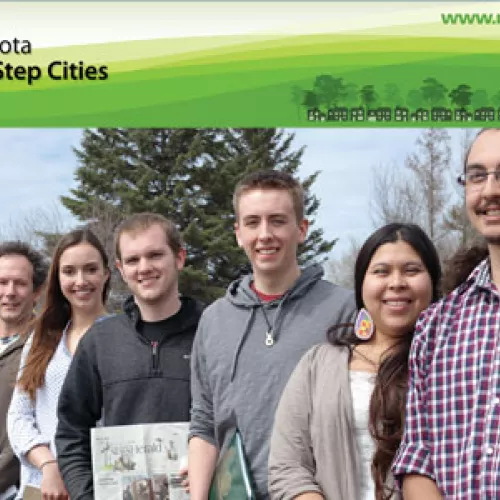Minnesota cities have been matched with UMD students this spring to work on sustainability issues, and the collaboration promises a greener Minnesota in the 21st century. Communities are jumping at the opportunity to join a project called Minnesota GreenStep Cities. The cities make a commitment to manage their natural resources and achieve their quality-of-life goals. They look at issues including building and lighting; land use; economic and community development; transportation; and environmental management. The five cities are Duluth, Ely, Grand Marais, Pine City, and Silver Bay. Leech Lake Band of Ojibwe will join the UMD collaboration this summer.
Michael Mageau, UMD assistant professor of environmental studies, set up spring internships for five UMD students through the Clean Energy Resource Teams (CERTs) program, the group that is managing the GreenStep project. All of the students are majoring in Environmental Studies, although they have a number of different minors.
For each city, first comes assessment, then priorities, then a commitment for future projects. The students assess what the city has done to date using a guideline of 28 best practices. Many times, the city has overlooked something they have already done. Zach Borich, a UMD student placed in Pine City for his GreenStep internship said. “The city already had projects in place that counted. They had a rain garden at Woodpecker Ridge and a community garden, too.”
After assessment, came the hard part, deciding on priorities and making a commitment to additional sustainable projects. Pete Ravinski, a UMD student placed in Duluth for his GreenStep internship, said Duluth took the commitment very seriously. “It took months for all of the departments and administrative offices to agree on what was most important,” he said. “Then it needed a vote from the city council.”
The students are part of a state pilot project; and UMD is the only school in the state to participate. At the League of Minnesota Cities conference this summer, they will spread what they have learned to help other cities and universities around the state. Learn more about GreenStep Cities.
The Student Experience
The experiences the students had were all different. Cities approached the GreenStep process in unique ways.
Borich said Pine City has been off to a really good start and they have a lot of community members interested in helping. “My favorite part was being able to brainstorm with my city contact, Nathan Johnson, and think of future sustainable projects,” said Borich. “They are working on energy efficiency and carpool sharing and they see the importance of building sustainable infrastructure.” Borich also sees a possible career, “This internship has showed me how to incorporate urban planning into environmental sustainability.”
Mike Kedrowski said Grand Marais had a more creative approach to get community members involved in the efforts.“After a closed meeting for council members, Grand Marais held a open community meeting,” said Mike. “We created 28 posters with each of the best practices on them, and asked people to paste red stickers on the ones they thought were most important. This was a great way to see what people actually cared about and what areas we should focus on. Some of the popular items were eco-tourism, education and green buildings.”
“Silver Bay has already successfully implemented many of the best practices,” said Emily Jahner. “The community realizes that becoming a green city can draw in people and it can make people want to stay.” Jahner said it was an exciting place to work because the Silver Bay Eco Industrial Park was already up and running.” “They’ve switched to energy efficient lighting, and they are planning to have an energy efficient boiler to power all of the city buildings.” They even have an elementary education outdoor classroom.
Dan Cahoon worked with the Ely community and he said their operations are going smoothly. They have already figured out which best practices the city has completed, and now they are planning for the future. So far, Ely has completed 16 best practices.“Ely has already gone above and beyond what they had to do,” said Cahoon. “Next, we are planning on putting in a biomass heating facility,” he said. The power plant will use fallen trees on the forest floor as fuel. “It that will help reduce emissions, prevent forest fires and, of course, provide heat for the city.”
Ravinski lives in Duluth and enjoyed working on improving sustainability in the city he calls home. “It was intriguing that Duluth considered the psychological well being of community members in their planning,” said Ravinski. “To make people feel safer spending time downtown, we looked at ways to slow traffic down. That was the Best Practice Number 11, Complete Green Streets.”
Veronica Kingbird, and Lucas Bratvold are on board to bring the GreenStep Cities process to the Leech Lake Band of Ojibwe this summer. “Leech Lake has always been conscious of the environment,” Kingbird said. “It will be good to work with leaders to document everything we have done and plan new steps to take.”
The Minnesota Greenstep City Project
Minnesota GreenStep Cities is a challenge, assistance and recognition program to help cities achieve their sustainability goals through implementation of 28 best practices. Each best practice can be implemented by completing one or more specific actions from a list of four to eight actions. These actions are tailored to all Minnesota cities, focus on cost savings and energy use reduction, and encourage innovation. University of Minnesota’s Regional Sustainable Development Partnership is the parent organization for CERTs, the organization that runs the GreenSteps Cities project.
Bill Mittlefehldt, the northeastern CERT coordinator is pleased with the progress. “So far, 66 cities have joined GreenStep, but there are 850 cities in Minn., so we have a lot to do.”
About the Local Government Energy Action Series:
This effort tells the stories of Minnesota municipalities, counties, and schools and the tangible results of their energy-saving efforts to inspire others to take their own actions.


